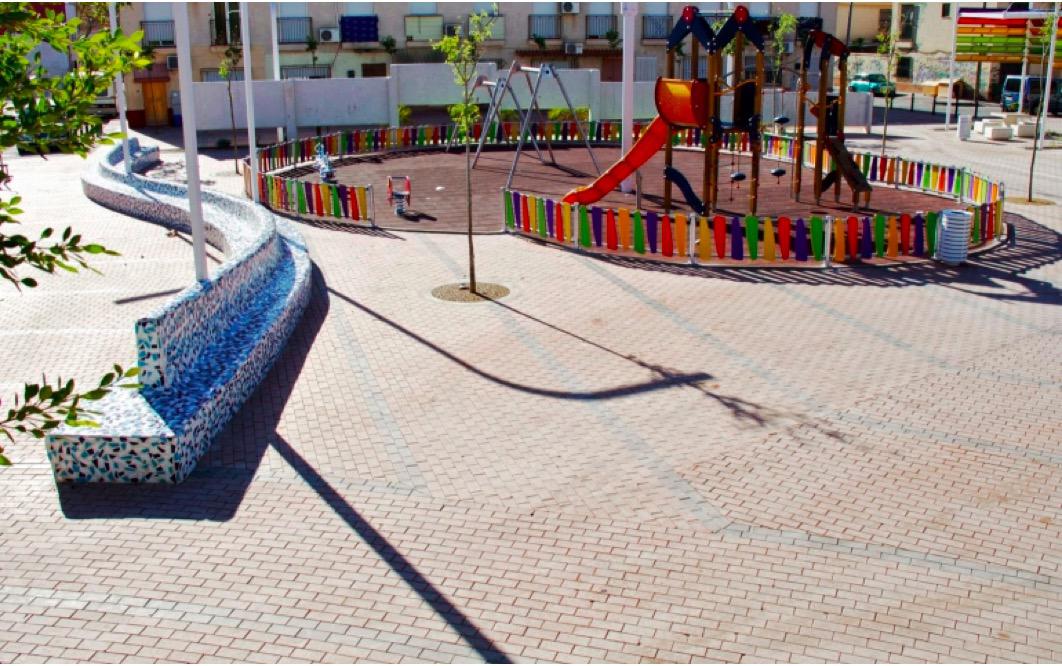INTEGRATED AND PARTICIPATIVE URBAN REGENERATION, MURCIA,SPAIN

PROJECT DESCRIPTION
From 2007 to 2013, the city of Murcia (ES) has developed an urban project which consists of the regeneration of the Espíritu Santo district using an integrated approach. The approach has been carried out in 3 strategic scopes:
- Improving the physical space;
- Improving the social and cultural environment;
- Improving the economic environment.
The procedures and methods employed involve the need to establish a close inter-correlation between environmental efficiency, technological innovation, knowledge and know-how, and the creation and consolidation of stable mechanisms for social and citizen participation.
By consolidating the equality perspective in all areas during the different phases, the neighbourhood became liveable again, opportunities went up, crime down, and the citizens took an interest in their environment.
In almost all of the actions, there is a special focus on ICT, minorities and improving work-life balance:
- Growth and quality in employability by improving professional skills (occupational training) trough integrated itineraries;
- Promoting learning, entrepreneurism and diversifying the economy towards emerging activities with a higher technological content;
- Helping create and consolidate companies, economic incentives, job insertion: diagnosis, development plan and accompaniment for labour insertion, etc.;
- Training and awareness of education, environment, equality and health;
- ICT as an element for promotion and innovation, as well as in the family and educational environment, with improvement of equipment and infrastructures;
- Increasing environmental performance;
- Territorial and environmental sustainability by increasing the collection of waste;
- Cohesion and social welfare, improving relations between educational centres and students’ families, reinforcing institutional capacity;
- Improving quality and effectiveness in teaching: learning as a factor of enrichment, growth and a key element of integration and reinforcing educational specialisation of teachers;
- Specific actions to improve access and enjoyment of culture and leisure, spaces, school reinforcement, free Internet;
- Classrooms, information points and municipal WiFi;
- Placement of solar panels and thermal installations, low consumption public lighting, etc.;
- A local administration closer to the citizens (flexible, effective and efficient), etc.
Activating: initiating
Coordination with local partners via a citizen and stakeholder engagement programme, centred around involving the district and incentivising residents to take part in the creation of a customised plan to first identify and then address the problems.
Stakeholders in the participation process:
- The municipality of Murcia (housing, culture, social services, education, health, information society, youth and employment and socio-economic data);
- The Local Municipal Board, NGOs, neighbourhood, cultural, youth and parents associations, pastoral council, representatives of minorities and groups at risk of social exclusion (in this case the important gipsy collective of the district), as well as individual citizens;
- Municipal and regional business organisations, regional government (especially education and housing), ALEM (Municipal Energy Agency), the two schools in the neighbourhood, and other entities. The latter through consulting and giving advice, managing assigned actions/activities, and participating in the internal monitoring and evaluation during all phases of the project.
The citizen participation project was conducted through meetings, direct contact and questionnaires leading to a draft proposal (actions, improvements, activities, etc.), which was presented to all stakeholders, after which feedback was initiated to further improve the project centred on the dialogue with citizens.
Mainstreaming: integrated management
Regarding the URBACT principles, the project focuses directly on all three items:
- Employability, skill training, integration itineraries, ICT capacitation;
- Ethnic minorities (immigrant and gipsy population) in risk of exclusion;
- Reducing carbon footprint, waste management, tackling water and energy consumption.
The intervention demonstrates an integrated approach to sustainable development by road-mapping realistic solutions to complex problems, working shoulder to shoulder with the community of the district. During the project, we strived and succeeded in identifying social, economic and environmental actions engaging the stakeholders to be the ones to identify and propose solutions to the problems they faced in their neighbourhood.
Proposals and commitment, which were achieved throughout a participatory process marked by the strong involvement of local stakeholders driving change, collaboration across the local (authority) spectrum and the development and implementation of real solutions.
LESSONS LEARNED / RESULTS
The neighbourhood became liveable again: as the crime rate decreased, the citizens took interest in their environment and opportunities for culture, sports and leisure. Furthermore, it fostered an enlargement of public space and the improvement of the environment.
We also took the opportunity to remodel squares and streets and introduce urban art. It allowed us to recondition the quality of cultural, sports, educational as well as social facilities to promote community development and transform the area into an attractive part of the city, with a special focus on ICT, performing arts, music and culture.
This regeneration project also included the adaptation of classrooms for artistic teaching, a fully equipped training centre for social inclusion as well as a centre for artistic and cultural production. We added underground trash containers and improved the illumination of the neighbourhood.
Socially speaking, we created a family support service and self-help groups which self-manage and promote coexistence and environmental education on the recycling and reuse of waste. Awareness training on equal opportunities and non-discrimination has been built up, as well as education and training to access employment in dance, music, theatre and video. We aimed at providing ICT, audio-visual production, soundtracks for video, photography direction, video art, sound and lighting for shows, fashion design, hairdressing, make-up artists and more, for all ages.
DATA
City information
Population size: 251-500 thPopulation development dynamics within the city administrative limits (at the time of the project): Stable
Population development dynamics of the functional urban area (at the time of the project): No data/not applicable
Website of the city: www.murcia.es
Project information
Project territorial scale:
NeighbourhoodProject geographical area: Periphery of the city
Project/building proportions: No data/not applicable; Project Area: No data/not applicable
Project main actors: City Government; Cultural, creative organisation, non-commercial private sector; Resident association, group, citizens
Project dominant property ownership: Public
Project development stage (at the time of description): Completely finished
Project duration: No data/not applicable
Project starting date: Before 2010



